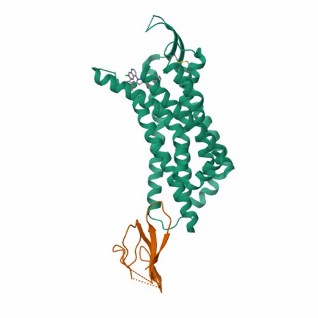Introduction of NTSR1
The neurotensin receptor family is composed of three subtypes, NTS1, NTS2, and NTS3. Neurotensin receptor type 1 (NTSR1) is a protein that in humans is encoded by the NTSR1 gene. It also belongs to the family of 7TM, G protein-coupled receptors, and is activated by the 13-amino-acid peptide neurotensin (NTS). It is a high-affinity neurotensin receptor with 7 transmembrane spanning regions and exhibits high expression in aggressive malignant solid tumors such as mesothelioma, non–small-cell lung, breast, and head and neck squamous carcinomas.
| Basic Information of NTSR1 | |
| Protein Name | Neurotensin receptor type 1 |
| Gene Name | NTSR1 |
| Aliases | NT-R-1, NTR1, NTRH |
| Organism | Homo sapiens (Human) |
| UniProt ID | P30989 |
| Transmembrane Times | 7 |
| Length (aa) | 418 |
| Sequence | MRLNSSAPGTPGTPAADPFQRAQAGLEEALLAPGFGNASGNASERVLAAPSSELDVNTDIYSKVLVTAVYLALFVVGTVGNTVTAFTLARKKSLQSLQSTVHYHLGSLALSDLLTLLLAMPVELYNFIWVHHPWAFGDAGCRGYYFLRDACTYATALNVASLSVERYLAICHPFKAKTLMSRSRTKKFISAIWLASALLAVPMLFTMGEQNRSADGQHAGGLVCTPTIHTATVKVVIQVNTFMSFIFPMVVISVLNTIIANKLTVMVRQAAEQGQVCTVGGEHSTFSMAIEPGRVQALRHGVRVLRAVVIAFVVCWLPYHVRRLMFCYISDEQWTPFLYDFYHYFYMVTNALFYVSSTINPILYNLVSANFRHIFLATLACLCPVWRRRRKRPAFSRKADSVSSNHTLSSNATRETLY |
Function of NTSR1 Membrane Protein
NTSR1 exerts different functions in many biological processes, including adult locomotory behavior, temperature homeostasis, regulation of sensory perception of pain, positive regulation of the apoptotic process, neuropeptide signaling pathway, chemical synaptic transmission, etc. Amongst, the well-studied is to activate multiple signal transduction in cancers to promote cell survival, proliferation, migration, and invasiveness.
Neurotensin (NTS) is a short, 13-amino-acid peptide that acts both as a neurotransmitter and a hormone, and exerts central actions that include the modulation of dopamine neurotransmission, hypothermia, opioid-independent analgesia and the inhibition of food intake. NTSR1 can mediate the multiple functions of testing as many as NTS, such as low blood pressure, high blood sugar, low body temperature, antinociception, and regulation of intestinal motility and secretion. And the structure-activity studies of NT have revealed that the minimal bioactive fragment corresponds to the C-terminal hexapeptide of NT, NT (8-13). Besides, NTSR1 has been linked, through Gαi/o, Gαq, and Gαs coupling, to a variety of intracellular signaling cascades including cyclic AMP (cAMP), inositol phosphate (IP), and arachidonic acid accumulation as well as the activation/inhibition of mitogen-activated protein kinases (ERK1/2 and JNK) and serine/threonine protein kinase Akt.
 Fig.1 Structure of NTSR1 membrane protein. (PDB: 7UL2)
Fig.1 Structure of NTSR1 membrane protein. (PDB: 7UL2)
Application of NTSR1 Membrane Protein in Literature
The author of this group aimed to uncover the potential connection between NTS/NTSR1 signaling and Wnt/β-Catenin pathway. They found that NTS/NTSR1 induced the activation of mitogen-activated protein kinase (MAPK) and the NF-κB pathway, which further promoted the expression of Wnt proteins, including Wnt1, Wnt3a, and Wnt5a.
This article evaluated the contribution of NTS to endometrial carcinogenesis. NTSR1 overexpression is a poor prognostic factor in endometrial cancer, highlighting the contribution of NTS in endometrial cancer progression and its uses as a prognostic marker, and as a potential therapeutic target.
This article not only evaluated the NTSR1 expression in pancreatic cancer patient samples but also explored the PET and fluorescence imaging of NTR1 expression in pancreatic cancer animal models. And their results indicated that NTSR1 is a promising target for pancreatic ductal adenocarcinoma imaging and therapy.
This article investigated the ability of activated hNTSR1, which was stably expressed by CHO-K1 cells, to directly engage G proteins, activate second messenger cascades and recruit β-arrestins. And found the characterization of the hNTSR1-mediated cellular signaling network will be helpful to accelerate the validation of potential NTSR1 biased ligands with an improved therapeutic/adverse effect profile.
The author of this group investigated the binding mode of SR48692 and other small molecule compounds to NTSR1, they applied an Automated Ligand-guided Backbone Ensemble Receptor Optimization protocol (ALiBERO), taking receptor flexibility and ligand knowledge into account. And their models provide new insights into small molecule ligand binding to NTSR1 and could facilitate the structure-based design of non-peptide ligands for the evaluation of the pharmacological potential of NTSR1 in neurological disorders and cancer.
This article suggests that methylation of NTSR1 is involved in the noninvasive and lateral growth of colorectal tumors, while low levels methylation may result in activation of NTSR1 and then lead to the malignant potential.
This article demonstrates that the activation of NTSR1 by NTS accelerates the proliferation and invasion of glioma, and high expression levels of NTSR1 and NTS will lead to a poor prognosis in glioma patients.
This review summarizes the roles of NTSR1/NTS and its mechanisms and discusses the possibility of its application to drugs targeting and clinical diagnosis.
This article indicates that the association between WM performance and the hippocampal structure is regulated by variation in the NTSR1 gene, and suggests that genetic background information should be taken into account in further studies of brain-behavior associations.
This article provides valuable insights into the functioning and stability of NTSR1 by analyzing the structural dynamics and thermostabilization, which will be useful in the future design of thermostable mutants of other peptide GPCRs.
NTSR1 Preparation Options
To obtain the soluble and functional target protein, the versatile Magic™ membrane protein production platform in Creative Biolabs enables many flexible options, from which you can always find a better match for your particular project. Aided by our versatile Magic™ anti-membrane protein antibody discovery platform, we also provide customized anti-NTSR1 antibody development services.
As a forward-looking research institute as well as a leading customer service provider in the field of membrane protein, Creative Biolabs has won good reputation among our worldwide customers for successfully accomplishing numerous challenging projects including generation of many functional membrane proteins. Please feel free to contact us for more information.
Reference
All listed services and products are For Research Use Only. Do Not use in any diagnostic or therapeutic applications.